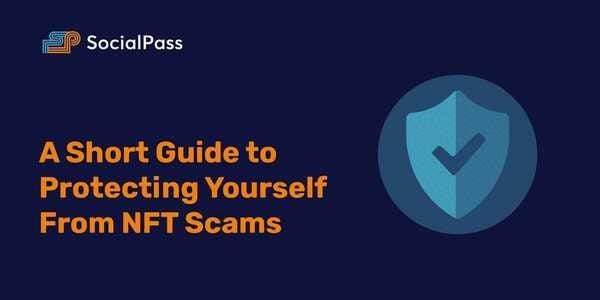A Short Guide to Protecting Yourself from NFT Scams

As a result of NFTs’ fast-rising mainstream adoption, holders are becoming increasingly vulnerable to unscrupulous individuals who employ various methods to rob them of their NFTs. Furthermore, the irreversible nature of blockchain transactions makes it nearly impossible for users to retrieve stolen NFTs. These high-profile scams have far-reaching effects, with experts opining they’ve played a role in the recent market downturn.
Let’s examine some common ways victims have fallen into these scamming schemes.
1. Phishing links:
Here, scammers impersonate a known NFT platform by sending out hoax advertisements, malicious pop-up links, and emails requesting personal information, which allows them to steal your digital assets. These nefarious links and adverts are frequently shared on NFT communities’ social platforms, such as Telegram, Discord, and Twitter. Recently, Yuga Labs’ Discord was compromised, and the phishing scammers stole NFTs worth $360,000.
2. Fake NFTs:
Fraudsters plagiarize a creator’s artwork or asset and then list them for sale on the NFT marketplace. These NFTs become worthless to buyers because the con artists have no right to the asset’s intellectual property. A typical example is an ongoing lawsuit between Nike and StockX, in which Nike accuses StockX of selling counterfeit footwear and trademark infringement.
3. Rug Pull:
This is when a person or group promotes an NFT project or collection, enticing investors with lucrative business plans, huge returns on investment, and a slew of rewards to holders. The founders vanish after receiving funds from investors leaving the project to crumble slowly. The apprehended founders of Frosties are an example of these dubious ‘rug pullers.’
4. Pump and Dump Schemes:
Here, a conniving group buys a large number of a specific NFT collection to artificially inflate its demand and fool investors into thinking it’s a valuable digital asset. After the price has surged (i.e., pumped), the scammers sell them (i.e., dump), cashing in on the big profit and plummeting the value, leaving the NFT holders with worthless NFTs. An instance is a lawsuit against Kim Kardashian and Mayweather for helping to pump and dump an NFT project, EthereumMax.
5. Discord Scam:
Discord is a popular site for NFT communities to socialize and promote their projects. As a result, fraudsters are rampaging several NFT Discord servers with false giveaways, malicious phishing URLs, fake airdrops, impersonation, and auto DMs to defraud people of their digital assets. Users must be cautious not to fall victim to these scamming tactics. The Mr. Bean NFT Discord community was recently targeted, with fraudsters sending automated DMs to steal members’ digital collectibles.
How To Avoid Being Scammed
1. Never click on suspicious links or pop-ups:
Always use the verified website for any transaction and never click on suspicious links or pop-ups. Also, if dubious sources request your essential wallet information, don’t give it out.
2. Use two-factor authentication:
You can enhance the security of your digital assets by utilizing strong passwords and enabling two-factor authentication for your NFT wallets and accounts.
3. Crosscheck transaction details:
Always double-check the price of the NFT you want to buy. Also, verify the transaction details you intend to perform to avoid pricey errors.
4. Conduct thorough research before investing:
Always conduct extensive research using the project’s social media accounts, websites, and the founders’ social media accounts to ensure their authenticity. Never trade NFTs unless you’re confident they’re genuine.
5. Examine the transaction history:
It’s essential to review the NFTs’ transaction history to avoid a pump-and-dump scheme. The public can leverage Blockchain’s open-source functionality to meticulously scrutinize the historical records of interested NFTs.
